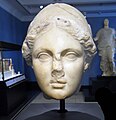Getty Villa
 | |
| Established | 1954, reopened 2006 |
|---|---|
| Location | 17985 Pacific Coast Highway, Pacific Palisades, California |
| Coordinates | 34°02′42″N 118°33′50″W / 34.045053°N 118.563824°W |
| Type | Art museum |
| Collection size | 44,000 Greek, Roman, and Etruscan antiquities |
| Visitors | 453,902 (2016)[1] |
| Director | Timothy Potts |
| Public transit access | Note: Ticket must be punched by bus operator in order to enter the Getty Villa |
| Website | www |
The Getty Villa in Pacific Palisades, California, USA, is one of two locations of the J. Paul Getty Museum. The Getty Villa is an educational center and museum that covers the arts and cultures of Ancient Greece, Rome, and Etruria. The collection has 44,000 Greek, Roman, and Etruscan antiquities dating from 6,500 BC to 400 AD. The UCLA/Getty Master’s Program in Archaeological and Ethnographic Conservation is here. The online GettyGuide as well as through audio tours tell about the items owned by the museum.
Collection
[change | change source]
The collection has 44,000 Greek, Roman, and Etruscan antiquities dating from 6,500 BC to 400 AD.[2] Among the outstanding items is Victorious Youth, one of few life-size Greek bronze statues to have survived to modern times.[3] The Lansdowne Heracles is a Roman sculpture that was probably copied from an older Greek statue.[4] The Villa also has jewelry and coin collections.[5] The Villa's library has 20,000 books covering art from these periods.[6] The Villa also displays the 'Getty kouros', which the museum lists as "Greek, about 530 B.C., or modern forgery" because scientific analysis is inconclusive as to whether the marble statue can be dated back to Greek times.[7] If genuine, the Getty kouros is one of only twelve remaining intact kouroi.[8] The Marbury Hall Zeus is a 81 in (2.1 m) tall marble statue that was recovered from the ruins at Tivoli near Rome.[9]
GettyGuide
[change | change source]The "GettyGuide" has detailed information about the items owned by the museum. This is available both at the Museum, at various points known as "GettyGuide stations", and externally on its website.[10]
Photographs
[change | change source]-
Gallery within the Villa
-
The outer peristyle, viewed from above
-
The Lansdowne Herakles, part of the museum's collection
-
Getty kouros, part of the museum's collection
-
Marbury Hall Zeus, King of the Gods, at the Getty Villa
-
Athena, Goddess of war, civilization, wisdom, strength, strategy, crafts, justice and skill
-
Main Courtyard of the Villa
References
[change | change source]- ↑ "Visitor Figures 2016" (PDF). The Art Newspaper Review. April 2017. p. 14. Retrieved 23 March 2018.
- ↑ "Art on View (Visit the Getty)". Getty Trust. Retrieved 2011-02-28.
- ↑ "Victorious Youth". Getty Trust. Retrieved 2011-02-28.
- ↑ "Lansdowne Herakles". Getty Trust. Retrieved 2011-02-28.
- ↑ Rogers, John (January 27, 2006). "Getty Museum reopening its much renovated villa". Seattle Times. Retrieved 2011-03-02.
- ↑ "Research Libraries". Getty Trust. Retrieved 2011-02-28.
- ↑ "Statue of a Kouros". Getty Trust. Retrieved 2011-02-28.
- ↑ Robert Bianchi, Saga of The Getty Kouros, Archaeology (May/June 1994).
- ↑ "Marbury Hall Zeus". Getty Trust. Retrieved 2011-02-28.
- ↑ GettyGuide - Getty.edu Retrieved September 3, 2008.
Further reading
[change | change source]- Filler, Martin (2007). Makers of modern architecture. New York Review of Books. ISBN 9781590172278.
- Moltesen, Mette (January 2007). "The Reopened Getty Villa". American Journal of Archaeology. 111 (1). Boston Massachusetts: The Archaeological Institute of America: 155–159. doi:10.3764/aja.111.1.155. ISSN 0002-9114. S2CID 191373656. Retrieved 2011-06-24.
- Storrie, Calum (2008). The Delirious Museum: A Journey from the Louvre to Las Vegas. I.B.Tauris. ISBN 9781845115098.







